By Lambert Strether of Corrente
Fun-loving readers, I noted Hopelb’s comment on Victory Gardens (June 9 on a Midwest flooding post)[1], and thought I’d put together a potted history of Victory Gardens with some remarks on climate change, with one or two World Wars I and II posters for color, but then I got sidetracked on the amazing posters! So I changed direction, and now I’m going to present a few of these amazing deliverables instead, bracketed with a brief contextualization from what seems to the only scholarly book on Victory Gardens in the United States (Rose Hayden-Smith, Sowing the Seeds of Victory: American Gardening Programs of World War I, and a conclusion about issues of scale for Victory Gardens in our own era. From Hayden-Smith:
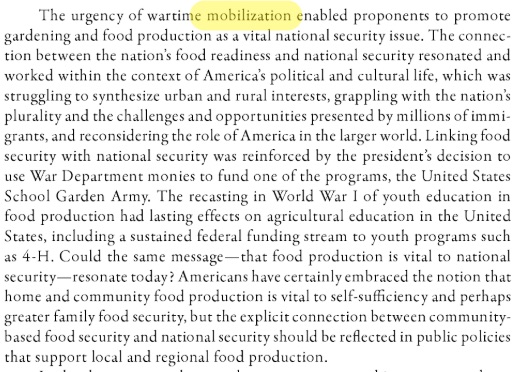
Note the key word: “mobilize.” This was also a key word in AOC’s Green New Deal proposal (see here and here) which sadly the Democrat leadership has managed to deep-six. More from Hayden-Smith:
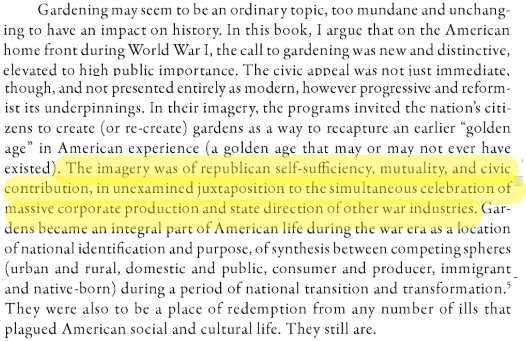
The imagery — OK, the propaganda — I am about to present is so fecund that it spills over the generous bounds set by Hayden-Smith (“Potato Pete,” for example, isn’t about “republican self-sufficiency, mutuality” or “civic contribution”). But when we recall that “Victory Garden” is so potent a trope that it survived all the way through to the 70s with “Crockett’s Victory Garden (the book; the television series) and up to today (“Join the Climate Victory Garden Campaign!“) we can see that wartime propaganda starting over a century ago has been very, very effective, not just as propaganda but in shaping the terms of culture for generations. Let me now wander through the posters, taking forking paths and tweaking tendrils.
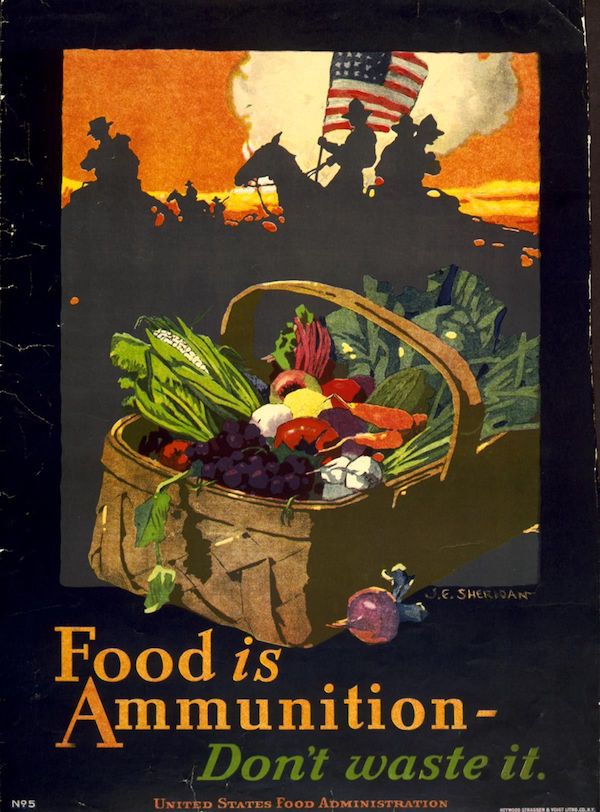
“Food is ammunition.” Did I mention militarism? Of course, we have plenty of militarism today, but I’m not sure — perhaps subject matter experts are already working on this — how to repurpose militarism into a thirst for gardening (though the Jackpot will perhaps serve as a lash and a spur)[2]. What does victory look like in a “war” against climate change? Then again, progandanda for the “War on Terror” has been very successful, and nobody knows what victory looks like for that war, either.
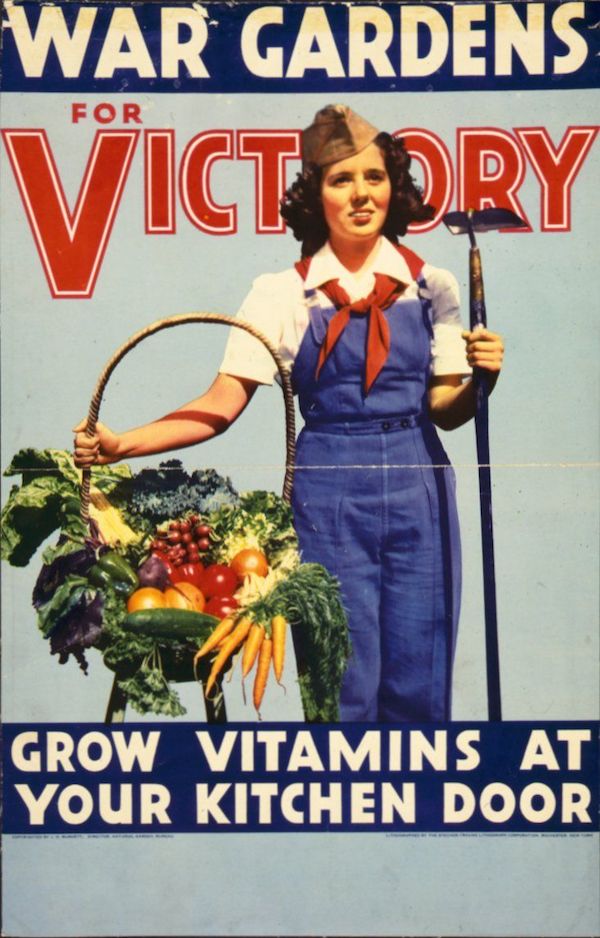
Many of the Victory Garden posters, like this one, are heavily gendered (the real men being at the Front, no doubt. But what’s with the Komsomol-style red neckerchief?) And what’s with the vitamins? If you have grow good vegetables — rather, if society grew and distributed good vegetables — you wouldn’t need corporate-produced and -mass-marketed vitamins, surely? (Yes, yes, vitamins supplement, but the message that vegetables are vitamins seems odd.)
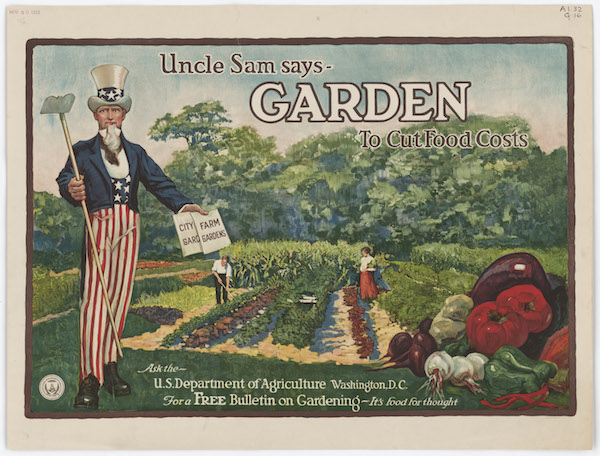
My first thought is, Wow! That looks like a splendid garden! No plant blindness here! (Nor row covers nor structures for beans or cucumbers to climb on, either.[3]) But notice the small print at the bottom: “Ask the U.S. Department of Agriculture Washington D.C. for a FREE Bulletin on Gardening–It’s food for thought!. It’s FREE! We have nothing like this level of mobilization today.[4] The Agricultural Extensions are the closest analogue, and not very close.
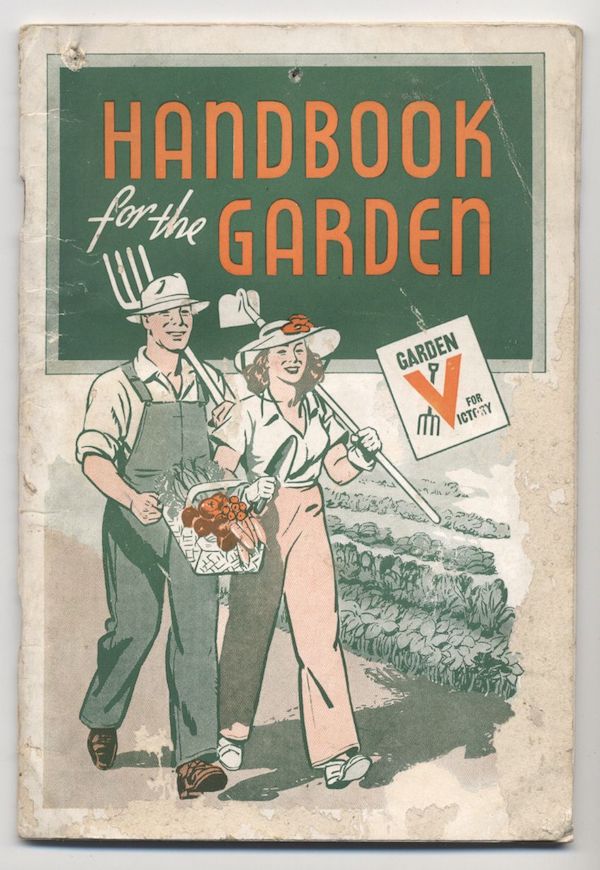
The cover of one of the many collaterals produced for Victory Gardens by — follow me closely, here — the government. Nothing against a dense network of NGOs and community gardens, but they don’t scale.
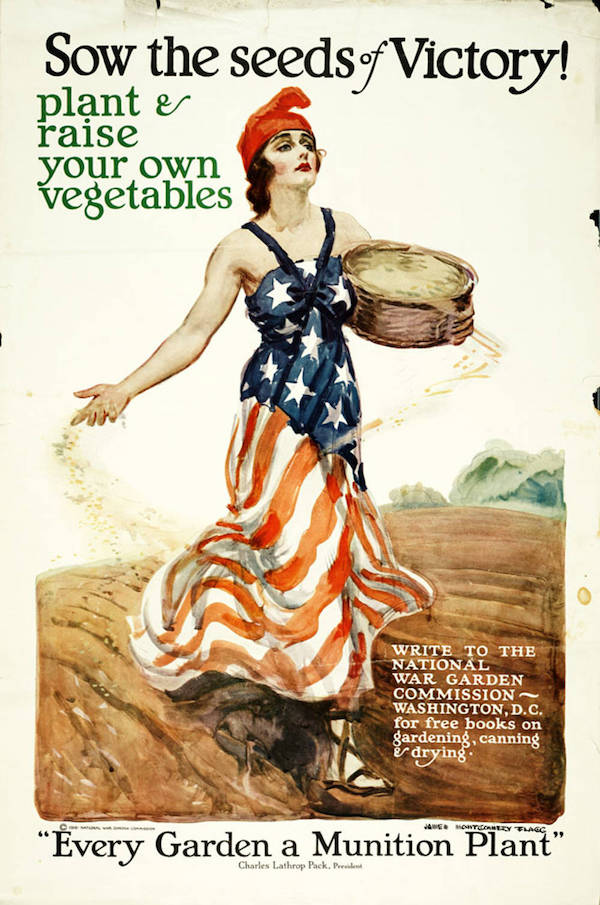
Leaving the gendered militarism — and covert reference to Millet’s (revolutionary?) The Sower? — aside, note again the small print at the bottom: “WRITE TO THE NATIONAL WAR GARDEN COMMISSION — WASHINGTON, D.C. for free books on gardening, canning, and drying.” Here again propaganda shades over into knowledge: The complete, yearly cycle of a really dedicated — or desperate, Jackpot-ready — gardener includes preservation, here canning or drying, though today we would add pickling. Naturally, if we were mobilizing today, the seeds would be branded Monsanto; seeds were still a public good, not intellectual property, in the days of Victory Garden propaganda.
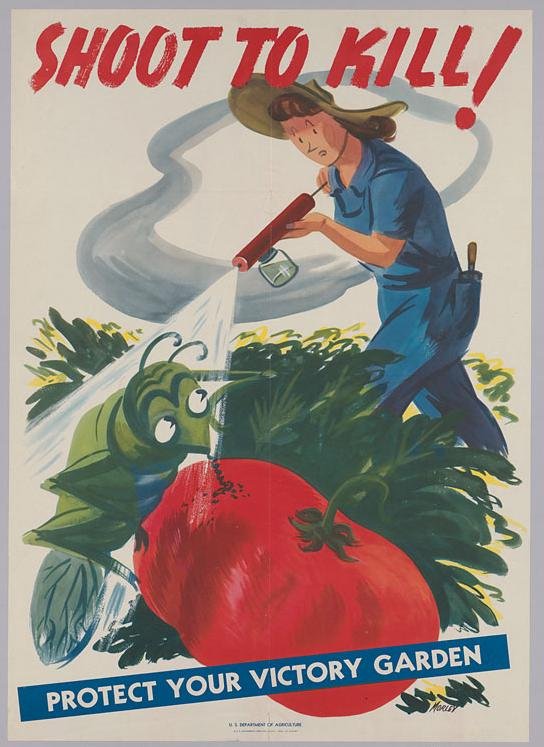
And speaking of Monsanto, let’s spray our plants with poison and pollute the water supply, to boot![5]
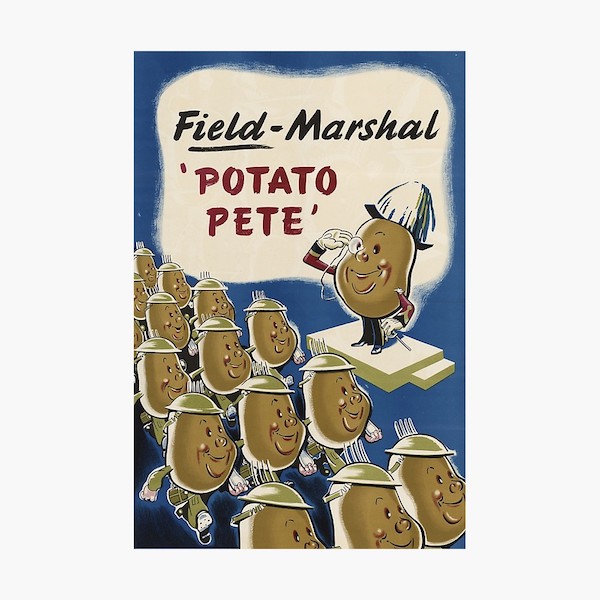
Michael Pollan would see “Potato Pete” as an example of plants communicating, which they do (just not with vocal cords and without a nervous system). The Bearded One, however, would see “Potato Pete” as an example of commodity fetishism, an enormous category error whereby “the relation of the producers to the sum total of their own labour is presented to them as a social relation of objects which exists outside them… It is a particular social relation between men [sic] themselves which in their eyes assumes a phantasmagorical form of a relation between things” (in this case a social relation between a potato personified as a Field Marshall, and other potatoes personified as soldiers).
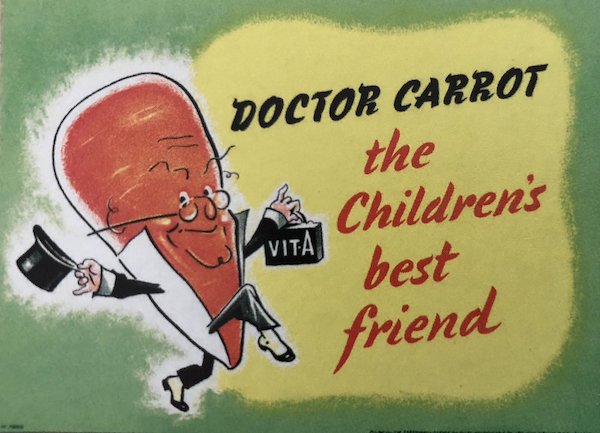
In presenting “Doctor Carrot” I make the same point as above, but I’d add that to this day I believe, because my parents taught me, that carrots are good for eyesight, and I’d speculate that their belief comes from wartime Victory Garden propaganda, to which they are both subject.
That is the end of my random walk through Victory Garden posters. Concluding–
Conclusion
It’s very clear that wartime propaganda can be staggeringly effective, and over generations, too. What is the relevance to the present day? (Beside the idea that gardening is a good thing in and of itself.)
First, we might ask ourselves what we can do in the case of a massive food failure by Big Ag (say a catastrophic failure of the Mississippi’s Old River Control Structure). Could modern day Climate Victory Gardens — possibly after a very bad year — pick up the slack? The history of Victory Gardens gives us reason to think so. The state of Oregon has a fine round-up:
Authorities also provided citizens with selfish reasons to have a Victory Garden. Home gardeners wouldn’t have to worry about crop failures in other parts of the country or transportation “bottlenecks” limiting supply. They would save money too since “even a small garden, if well planned and tended, will yield $25 to $50 worth of vegetables.” People with Victory Gardens would be healthier since “there’s nothing like exercise and better meals to improve your health, which is doubly important in wartime.” And, officials asserted, home grown food is tastier: “It’s not only because you raised it yourself, with sweat and care. Vegetables and fruits do have a better flavor when they are really fresh, as they are when they come right from the garden.” And for those suffering from wartime anxiety, “there isn’t a better hobby for lots of people. It makes you feel good. It relaxes your nerves. It’s a family enterprise that brings together father, mother, son and daughter.” Even the community benefits of gardening could make the individual feel better since gardens “promote neighborliness, sociability, cooperation.” With home gardeners providing 40% of the country’s fresh vegetables by 1944, the individual could feel patriotic about the contribution.Footnote 2
(Note all the good reasons for gardening, like “[i]t relaxes your nerves.” Sometimes the best propaganda is the simple truth!) That doesn’t prove that Victory Gardens can feed the country, of course, but it does prove that they scale. (Microgardens in Russia produce 40% of the country’s agricultural output.)
One question we might ask ourselves is whether the United States government, today, has the capacity to mobilize on the scale of World Wars I and II, or whether the last decades of neoliberalism’s assaults have hollowed it out beyond repair. Mobilization, again, is an explicit goal of AOC’s version of the Green New Deal, and the reaction of both parties’ (current) leadership to her resolution suggests the answer to that question might well be “no.”
A second question we might ask is the extent to which neoliberal infestations would cripple any mobilization achieved. Not only would corporations seek to use Climate Victory Gardens as marketing vehicles for their own — biosphere-malignant — products, they would surely seek to optimize garden distribution to maximize profit, as opposed to yield for those who most need it (much as Farmer’s Markets, sadly, rarely solve the problem of food deserts, being far too NPR totebag-adjacent).
All that said, we still must conclude that Climate Victory Gardens offer enormous potential, at the very least as a hedging strategy against food failure. We should be encouraging this form of public policy, seeking to eradicate neoliberal infestations where found.
NOTES
[1] Google, as we might expect these days, can’t find it; not being able to find text I know exists — often, because I wrote it — is a regular feature of my Life With Google™ these days. Must be the optimization.
[2] Oddly, the Earth One protagonists in Gibson’s Peripheral seem to subsist mainly on junk food. This is thematically appropriate, but if you look at the book as an exercise in world-building, you’d think that there’d be every incentive for gardens.
[3] I wish I knew of a history of garden apparatus. For example, when were “row covers” innovated, and why? Did we always need them, and just could not use them because we had no suitable fabric? Or did we once not need them, and then — perhaps beause insects adapted — we did? I’m guessing this sort of history would be useful in the same way that tracking tree rings is useful.
[4] The (controversial) FAQ for AOC’s GND resolution includes this: “Work with farmers and ranchers to create a sustainable, pollution and greenhouse gas free, food system that ensures universal access to healthy food and expands independent family farmin.” What about the horticulture and gardeners? Especially given the enormously successful branding of Victory Gardens?
[5] The first legislation regulating pesticides was introduced in 1910, so apparently harms were known well before this poster was created.


Note the survival of many Russians depended on dachas, little private gardens and cabins, during the transition from Communism to parasitical oligarchical resource grabbing, before settling down to the present system.
https://smallfarmersjournal.com/russian-dacha-gardens/
IIRC, not too long ago Russia encouraged a return of Russians, who had left the country, to come back home. Perhaps, even people who had Russian heritage, but we’re born out of country. It coincided with the fact that many people were unhappy in the lifestyles and/ or governance of their present countries. Russia offered expedited processing of returns or immigrants. Included were substantial assistance with work, university, housing, etc, needs. And, the really interesting thing was that they could have their own little dachas in the countryside. I am not sure if they owned them, or just could have time in the year to live, grow gardens for awhile each summer.
Not just those who had left. 15,000 white farmers facing land expropriation and murder in South Africa accepted generous offers of land and safety in Russia.
https://www.washingtonpost.com/world/europe/why-russia-is-wooing-south-africas-white-farmers/2018/09/23/3308a7c4-b6a3-11e8-ae4f-2c1439c96d79_story.html
See Farmlands, by Lauren Southern for a view of why they left.
https://www.youtube.com/watch?v=a_bDc7FfItk
Lauren Southern is not a reliable source, particularly when it comes to anything involving race relations. She is a bona fide racist and xenophobe and endorses some pretty reprehensible people and policies.
Oh, so rather than discussing facts and issues, your clarion call to follow Your personal definition of her politics, and call to general censorship, includes “Xenophobia” when it comes to second and third countries?
Your 15 minutes of sanity might have expired. Love your name.
The WP link provided contradicts the statement above in this comment.
I am named for my mother’s maternal grandmother, and, you guessed it, she was a Victory Gardener. From her garden in Buffalo, New York, my great grandmother fed 8 people.
Am I a vegetable gardener too? You bet!
> Am I a vegetable gardener too? You bet!
That is a good thing to be! However, I think that if the propagandists were thinking in terms of decades*, instead of years, they’d be pushing perennials like fruit and nut trees as well. The canopy is important! Also the importance of good soil!
NOTE * The Long Climate War™
On it!
I am growing three fruit trees. My lemon, pomegranate, and fig trees are irrigated with greywater from the washing machine.
Some reason you can’t use shower and sink as well?
It always gets down to elevation, of the drain and relation of the trees to drains.
You know about the right kind of soaps and cleaners to use?
https://greywateraction.org/faq/what-soaps-and-products-can-i-use-with-my-greywater-system/
*Garden below house* is always better than vice-versa if seeking a planting spot.
Don’t know about Arizona Slim but in my case the the washing machine plumbing was trivial to reroute. The rest of the house would have required major surgery to reroute.
This needs to be built in from the start.
“Washing machine plumbing”, as simple as connecting an extension to the discharge hose–watch the “head” or elevation, no higher than top deck of machine, lest you burn out the washing machine pump. Prudently. drill hole through wall behind machine, if no window, to garden.
“This needs to be built in from the start.” Not necessarily. A friend had access under his floor to sink and shower/tub drains before the merged and went to sewer. Beyond the sewer gas P traps.
He installed ball valves, with a “T” on vertical, or sloped pipe section above ball valve. When ball valve open, flowed to sewer. When ball valve closed, water backs up and spilled sideways out to the garden through T. On diagonal pipes, roll T slightly up, then 1/8 angle to horizontal pipe to garden. Slope downhill 1/4″ per lateral foot to trees or ground. On vertical pipe sections, put a 1/8″ jog up, like the angle in the letter “r.” with two 1/8 fittings. Prevents dribbling of sewer bound water to garden.
Second option, access under sink. As above, to sideways pipe drilled directly through outside wall to garden.
2″ copper is best for heat dissipation of washing machine or shower hot water. You don’t want to dump hot water on plants. Anyone can learn to sweat or solder copper pipe. Including my 12 year old niece, with supervision! If you are confused, hire a plumber, or just get this book: Builder’s Greywater Guide by Art Ludwig.
Yes to pre-plumbed diversions. In most health and safety codes, the liquid waste stream from a dwelling is mandated to be sent to a centralized sewage collection system, whether it be to city sewer or septic tank. So, from personal experience, I can attest that the diversion of washing machine and or kitchen sink liquid waste streams to a garden patch “behind” the house has to be done ‘on the sly,’ or you get “Red Tagged” by the Inspectors. This entails re-inspection later to assure compliance, for which you pay an extra fee, and lots of ‘unwanted attention’ from the Inspectors for quite a while after.
I have had to refuse to install separate human waste plumbing piping and ‘greywater’ plumbing piping systems in houses that were to have mortgages. Once the Bank gets involved, everything, other than the finances, of course, has to be ‘by the book.’
In the few cases where I helped install a separate ‘greywater’ system in a dwelling, I ran it to a settling tank first, usually a 55 gallon drum on end in the ground, and then out to the ‘fields.’
Good news Ambrit:
California greywater plumbing code:
“1502.1.1 {HCD IJ Clothes Washer System. A clothes
washer system in compliance with all of the following
is exempt from the construction permit specified in
Section 1.8.4.1 and may be installed or altered without
a construction permit:”
http://oasisdesign.net/greywater/law/california/currentcode/
Whatever you do, build it to code.
“California plumbing code greywater” gets you lots of sites and video.
Nice. I recall a touching story about my paternal grandmother, whom I never met. She died before I’m was born during the last month’s of WW11. She was ill for most of the war, so did not have a victory garden, but they were farmer’s, so grew a lot of their own food. My aunt, her youngest daughter, one time time talked about her mother. There were six children in the family. All her life , before her mother died, she remembers that any person who was hungry could make their way to the farm house and be given something to eat. During the Depression ,if farm did not produce a lot, the family always had onions that grew in their gardens. If the last pig was eaten, the chickens too ( always some eggs), the kids would be fed onion sandwiches. Bread was always made… a real luxury would be onion with butter sandwiches. Any, then called “hobos”, or families on the move, by word of mouth would hear of the generous and kind farmer’s wife on the small farm by the river. What ever the family ate was always shared with anyone who showed up at the door.
my grampa told a similar story.
3rd generation bohemian immigrants still farming the 3 Sections that the brothers had acquired…and 11 year old grampa didn’t even know the Depression was happening, until a car broke down in front of the place. those folks ended up living with them for years, becoming integrated with the family farming(they were still at all the family functions until well into my youth).
That story, and many many more like it, is why i’m a nut for autarky on our little place(or, as near as i can get).
it’s the original hedge fund(in this case, a hedge fund of canned green beans* and dinner on the hoof mowing the yard)
and * my 13 year old has been helping my mom and stepdad can the beans….only cannable that everyone always likes a lot,lol.
I told him that learning this skill will attract the “right kind of woman” one of these days.
the eyerolling is still ongoing.
my family never throws anything away…still have the original canning books from the time of those posters…although we’ve kept abreast of new temps and pressure times and such. some of the canning equipment is older than my mother.
The Mississippi is fundamental to markets for corn, soy, and wheat which is what most of the mid-West farmers are focused on. The Victory Gardens were focused on market vegetables that are not a major mid-West set of crops. That transportation network is quite different as those products are grown in many different places with major shifts occurring seasonally.
To go along with our Victory Gardens, we will also need to add root cellars so that root vegetables can be kept over the winter in our homes instead of just buying fresh produce at the grocery store.
I saw some posters for gummint pamphlets on root cellars (I forget which war) but couldn’t find them again when I wanted them!
More than a poster:
https://extension.umd.edu/sites/extension.umd.edu/files/_docs/locations/frederick_county/Ag%20Pubs%20FS803%20Root%20Cellars.pdf
https://sos.oregon.gov/archives/exhibits/ww2/Pages/services-nutrition.aspx
Fwiw, I think pro-gardening propaganda wouldn’t be that hard; from previous NC posts it sounds as if gun manufacturers have already come up with a winning formula on Instagram that could be borrowed.
Re: growing vitamins at your kitchen door, that poster seems very in line with the Domestic Science /Home Economics being taught to young women at the time. The third chapter of my grandmother’s Woman’s Home Companion Cook Book, copyright 1942, is called “Nutrition” and explains vitamins to the reader as: “Vitamins are substances occurring in foods in minute amounts which exercise specific control over vital processes. At least nine vitamins have been found to be important in human nutrition…_” It then lists the nine vitamins and what foods supply each of them.This is followed by this bit of propaganda:
“A NATION IS AS HEALTHY AS THE FOOD IT EATS
“We in America are a privileged people — we have in abundance a greater variety of food at all seasons of the year than any other people of the world. Out of this bounty the meal-planner must select the right food to build the health and stamina of her family. To do so she must know what to choose.
“To make this job easy we have prepared this simple chart. It is based on the rules for good nutrition and is in harmony with the Government’s nutrition program.”
The next spread is a lovely color plate featuring the eight (8!) necessary food groups:
– Milk and cheese (one quart for each child, one pint for each adult; tips for reducing food cost by using dried milk are offered)
– Meat, poultry, and fish (one or more servings per day)
– Eggs (one a day, if possible)
– Butter, other fats (2 tbsp/day butter for adults; use peanut butter for children)
– Green, yellow, and leafy vegetables (for Vitamin A; one or more servings per day)
– Citrus fruits, tomatoes, pineapple (for Vitamin C; at least one serving per day)
– All other fruits and vegetables (two or more servings per day, at least one of which should be raw)
– Bread and cereal (two or more servings per day, counting 2 slices of bread as a serving)
I think the green-and-yellow vegetables bit, and women’s responsibility for providing them to their families, had some staying power. Iirc, there’s an episode of The Andy Griffith Show in which Aunt Bea worries who will feed Opie one green vegetable and one yellow vegetable at night if she takes a trip somewhere – because apparently Andy, as Opie’s father, wouldn’t know to do that.
In the UK there was the Dig for Victory campaign
British Library
https://www.bl.uk/learning/timeline/item107597.html
Dig for Victory
https://dig-for-victory.org.uk/
and currently https://www.incredibleedible.org.uk/
are getting people to reclaim land for food in their towns.
‘WAR GARDENS for Victory’ … Humm…
Change that to ‘MOARRR GARDENS for Life !’
‘;]
The language of warfare features prominently in these posters; ammunition, war, cut, shoot, kill. Is it any wonder there’s a mass extinction underway? These ideas are so deeply embedded in our systems now that those wishing to heal the environment with policy still evoke such language habitually. Even candidate Sanders, who at least acknowledges the damage being done to the environment and the need to address it, used the phrase, “…to combat climate change” in a recent email appeal.
In the context of a range of issues discussed at NC, Lambert sometimes asks, “What would Victory look like?” People smarter than me have observed that victory means “nothing left to conquer” so it’s worth asking where we might operate from a place more aligned with that. The joke about Democrats nowadays is, “always fighting, never winning.” That’s insightful. The approach isn’t producing victory in the political sphere (for people or planet) any more than in our national security or industrial policy.
That is so interesting. 1942…Propaganda, yes. But what strikes me most, putting aside any specific arguments about whether meat is healthy in a daily diet or not, is the general nutrition profile of the food groups. There were probably much of the foods not as adulterated by poisonous pesticides, herbicides in the general supply, as in home gardens, as today. A large percentage of our children in this country are hungry daily. Many of those who have food it is crappified processed and/ or junk food. Even in most school lunch programs, this is true. Imagine if kids were fed the 8 necessary food groups…. I also should include the hungry adults. Just read that more older adults are going hungry. As Reverend Barber points out in his “Poor Peoples’ Campaign”: to perhaps paraphrase, It is shameful that in this rich country that there are poor and hungry people.
When I started getting serious about gardening my mom gave me her book, The New Victory Garden by Bob Thomson. He breaks everything down into months, although you have to tweak it based on your zone. The concept of a victory garden was much more approachable for someone new to farming because it’s smaller scale, no large equipment, and you still get a lot out of a small space.
One of the reasons I feel so comfortable living in Maine is because of local food availability. One farmer last year told me Maine had the fastest growing number of small scale farms in the country. Added mine to the list this year!
On a related note, that someone was kind enough to introduce me to:
The U.S. Department of Agriculture’s Pomological Watercolor Collection is an archive of some 7500 botanical watercolors created for the USDA between the years 1886 and 1942 by around five dozen artists. https://en.wikipedia.org/wiki/Pomological_Watercolor_Collection
My grandmother won a National Canning Contest sponsored by the government Victory Gardens
during World War One. The United States Food Administration was very effective in getting people to conserve
and garden. Too bad it was concentrated around a war.
Frank Lloyd Wrights sister Maginel contributed the artwork for several War Garden posters.
Canning contest: What a fun family memory! Thanks for sharing.
I just canned some Medlar pepper jelly, from our 2 trees (last year’s crop).. about 45 8oz. jars worth. Not to boast, too much .. but it’s really good !
If you have a kitchen… or access to one, you should learn to can, as there is nothing like enjoying the fruits of one’s labor, not to mention having something available should an emergency arise – also, having goods available in winter, when many things are otherwise out of season. I give away, as gifts, what we don’t use .. and they ARE much appreciated by the receivers. One doesn’t need much, other than the basic canner’s equip. .. plus jars, lids, and rings. Good sanitation is important too ! Mrs. polecat learned canning from taking Master Food Preserver glasses via UCD Co-operative Extention Adult-Ed classes back in the 90’s.. whereby Mr. polecat pick-up learning to do the craft .. now I’ve become the canner in the household !
Even if one doesn’t garden, one can still put up their own victals if one has access to fresh fruit, vegatables.
My father put in a Victory Garden. Being an older Tennessee gentleman, he hired a man with a mule and plow (we lived on a city lot). He and i planted the seeds in tbe prepared rows and I watered. That meant I got to play in the water during hot Oklahoma summers.
My mother always canned and pickled excess produce. We ate very well; there was no fast food, no glyphosate and no factory animals or boxed so-called foods.
There are books covering four season gardening and food preservation. Takes time, though – lots of it.
Sorta OT, yesterday Dancing Oaks Nursery, between Salem, Corvallis and Dallas OR, had its annual Pollinator Festival. Lots of stalls with free info from bee, butterfly, native plant preservation groups as well as ag agents and OSU. Mason bee homes, free plants, activities for kids. Maybe this idea could be stolen in otber areas.
Veggies are nice and all, but why not a Victory Orchard?
Unlike lesser living things that take 120 days to come to fruition, we’re talking the better part of a decade to get up to speed, and along the way you get to watch the kids grow up and become upright citizens of the community, providing shade & savory fruit and a sense of belonging to the neighborhood. Radishes & Carrots can’t touch that.
Gardened and foraged in some uniquely polluted places. Thank GOD for some of the Food Coop folks, who set us up with proper testing at the local university/ community colleges. As discussed previously: deindustrialization, inflation, unemployment and concomitant destruction of safety net programs had a LOT to do with this. But so did concerns with industrial agriculture, food deserts and hybrids & GE crops being about everything BUT flavor, nutrient value and sustainability. Real food simply tastes like something. We were living in a city neighborhood full of eighty year old Italians and Blacks who loved to garden, cook and EAT. Getting palladium, manganese, all sorts of heavy metals was what made it interesting?
https://www.commondreams.org/views/2019/06/23/growing-case-ban-fracking
https://www.tenthacrefarm.com/transitioning-to-a-no-till-garden/
Interesting concept, but one major problem with pushing “victory gardens” today is that many people live in rented apartments with little or no land available to grow anything, or their landlord forbids tenants digging plots in the lot. There are community garden centers but they are often few and far between.
As far as “pesticides” go, do not fool yourselves into thinking that the ones of yesteryear were less benign than the ones we have now, as many of them were derived from natural sources and were not artificially designed to break down after a short period of time. However, I also recognize that the judicious use of pesticides is a necessary evil, as in many cases, ravenous insects will literally leave you with nothing as what I have seen happen with watermelon plants when the squash beetles get at them. We have to be careful not to fall into the trap of the naturalistic fallacy.
Food grade Diatamacious Earth applied in a gallon sprayer will do in a good many many-legged beasties preying on veggies or fruit. In laymans terms, it’s as if they’re having to walk over a boulevard of broken glass bottles to be able to bother your efforts.
DE works better dry, IMO.
but it’s hard to do to major infestations(like our now third year of grasshoppers galore(not as bad as last two years, and waited til almost june to appear))
compost tea…or “bug juice”(made from the ones you can catch, under the theory that they’re sickly)…sprayed all over everything works pretty well.
currently, i mix fish emulsion, “Medina”(a regional concoction) and a “lady bug” brand thing that has more micronutrients with a little bit of Neem(interferes with feeding behaviour) and spray it liberally to discourage the hoppers.
plants dig the foliar feeding, as well. aside from a few caterpillars(only in my trap crops), hoppers are the only pest i’ve had.
the goal, of course, is to grow the soil healthy enough in order to grow the crops healthy enough so they can resist the pests and whatnot.
i’ve been working on the current garden for 3 years now…but due to biblical hoppers, have only been able to grow the herbs(home for good bugs) and covercrops and trap crops needed this year.
…and i still need prolly tons of good manure and compost to fill up the beds.
if the hoppers would ever get done with this run, I’ll be good to go next spring.
if we had to eat solely from this place, we’d have been eating alot of fried hopper fritters.
I intend a second chicken/guinnea house over here this winter(the fancy little bantams don’t roam like mom’s larger breeds, and aren’t as destructive)…and i’ll be moving the geese over here this week.
coon dog and cats…everybody’s eating grasshoppers.
In the places where I have lived in the Upper Midwest, the cucumber beetle infestations of both the striped and spotted kind were so severe that if you did not use something Permethrin-based like Vegetables Plus, they would kill the squash and melon plants after only sprouting a few leaves long before you would ever see a single squash or melon.
One dirty secret that a lot of “organic” growers do not tell you is that the “organic” certification allows its growers to use various natural pesticides that are even more dangerous or long-lasting than their synthetic equivalents.
Domestic plants are just as dependant on human aid and protection for their survival as domestic animals, and without us, many of them would go extinct. While we should not go overboard with our pest-control substances, if we did not use them in some form our another, humanity would probably be facing routine famines. Plants have many enemies in the natural world, unfortunately.
i admit that the first hopper year saw me using horrible shit to try to save all the fruit trees i had planted.
i hated myself for it…but couldn’t take the thousand dollar loss.
but even diatomaceous earth is hardly eco-friendly….comes from giant dusty open pit mines in canada.
and things like rotenone(now all but banned) was a horrible “organic” insecticide.
sabadilla dust(flower derived) is harder and harder to find because it’s indiscriminate(it’s also the only “organic” i’ve found that works on squash bugs and harlequins—I rotate, strategically introduce chickens and hand pick the buggers and burn them,lol)
there’s some things i won’t even try to grow here because of bugs or disease—that had often been made worse because of chemical farming(corn ear worm, for instance)
and i have to be careful with saving seed from curcurbits of any kind, because of our native “buffalo gourd”(curcurbit foetida), which has a chemical naturally in it that can give you an internal rash from hell(!)(with special processing, the seeds and the giant tubers are edible, and were a staple with the precolumbians around here.) it would suck for my heirloom sandia or french pumpkins to get that irritant gene
it’s hard, sometimes.
but that’s why one diversifies.
if the pecans don’t make, the acorns or the mesquite beans will.
i intend to try a fall garden again, next year. many of the worst bugs are gone by then.
(and it’s been 12 years since i’ve had a real garden, due to disability and then housebuilding for 4 years.
I’m 3 years into my five year plan)
Hopelb’s comment on Victory Gardens also got me researching them as well at the time. My grandmother had a garden out the back when she was alive and I am willing to bet that this was a victory garden that was never replaced by lawns after the war was over. I thought that people might like two more links on these gardens-
https://www.treehugger.com/lawn-garden/vintage-photos-world-war-ii-victory-gardens.html
There are photos here of these in the middle of New York City and you can see skyscrapers in the background. Another link below mentions another aspect of victory gardens which was preserving the food that you grew so that it was not all from garden to table-
http://www.sarahsundin.com/victory-gardens-in-world-war-ii/
These posters remind me of the “Bolshevik in your Bathroom” poster. Anyway, here is a thought; you might want to use a Victory Garden poster instead of a photo of a plant in the Water Cooler every day.
What might make sense in 2020 are Victory Garden T-shirts. Some of these posters might work as a T-shirt.
Maybe with the word victory spelled-out as VIKTORY .. so as to throw all the 20% credentialed ‘resistance’ wokesters .. those who probably never ever had dirt under Their spotless nails .. into fits of ‘russia, russia omg !’ pique !
Better yet, just print it in Cyrillic ! .. along with a little green man of course.
‘;]
Or fake-Cyrillic. Surely everyone here has seen English words with some letters altered around to look Russian . . . to send some kind of message or make a statement.
If someone could write Victory Gardens in “fake Cyrillic” that could be copy-pasted and used everywhere. Something better than Victorygrad Gardensky, for example.
My grandmother used to can like a maniac. It was fantastic-peaches, cherries, and pears in big glass Ball jars. Such a treat! She also had a large garden behind the house.
Today, I have to rent my apartment(a share because housing is quite dear) and the closest community garden that offers allotments is 4-5 miles away. You need a car to get to it. The allotments are pretty small and our growing season short. We are not allowed to even have anything on our decks at the apt complex. Most of the new housing being built around here is apartment complexes (to rent), and affordable starter homes are hard to find. For the most part, owning a home(and thus having a yard to put a garden in) is out of reach for so many, including myself. I grow what I can in my little allotment(beans, tomatoes, potatoes, onions, etc), but it doesn’t go very far. I hope some day before I die I’ll be able to have a proper garden like my grandmother had (I dream of a root cellar!), that could feed a family, but I am not optimistic.
Back in the day, there were also gardens associated with public schools. It was thought that the planting and tending of vegetables would have a beneficial effect on the students, especially when they were rural people thrust into urban environments.
Curiously these gardens seem to have died out during World War 2. The last mention of them I was able to find the last time I looked was in 1943. The return of local urban gardens, at least in New York City, had to await the hippies and Puerto Ricans of the late 1960s. At first fought fiercely by landowners, landlords, and city authorities, they have now been accepted, bourgeoisified and gentrified and most of them are locked up at night. I keep a stray cat that was expelled from one as a danger to something or other. ‘So it goes.’
Quite a few schools around here have gardens. It’s more of a private initiative, though, with the school board permitting it.
In New York City apparently it was sort of an upper-class thing to initiate or sponsor school gardens for the benefit of the lower orders (those who went to public schools; the offspring of the rich went to private schools). I don’t know if much public funding was involved.
In a highly urbanized area placing gardens on rooftops might be appropriate. See the ‘Hanging Gardens of Babylon’ and ‘Green Roof’, both of which are Wikipedia articles. This obviously attractive amenity is seldom constructed in New York, however, probably because of the higher initial costs.
Won’t climate change reap havoc with gardens as well as farms?
Another question: I guess you guys aren’t fans of vertical farms, green rooves, and basement grow ops?
No basement.
Seriously: gardens get much more intensive care than farm crops, so they should be less impacted, over all. Home gardeners have a much smaller investment, too, so hopefully will adapt, year to year. If anything, it’s a safeguard against the disruptions of climate chaos.
Green roofs are OK, if the building is strong enough – it’s otherwise unused space. Vertical gardening strikes me as a boondoggle – why put up a building, at huge resource cost, when dirt is better? And basement grow ops waste great amounts of electricity, only necessary where it’s still illegal.
>>Why put up a building to make a vertical garden
1. If we ever did eliminate the need for them, what about parking garages?
2. I don’t think the vertical gardens need to be at the same level of structural soundness as buildings for people, do they? Just a giant trellis and a support for it?
For lots of us, gardening was a response, or adaptation in recognition of climate change. For many folks, this has been a big chunk of everyday lives for decades. Biodiversity, resiliency, soil micrbiome, tilth and ecology were more than media buzzwords to a fair portion of gardeners/ foragers growing up after Silent Spring, the Keeling Curve and The Last Whole Earth Catalog.
https://www.naturallivingideas.com/edible-wild-plants/
https://www.ecolandscaping.org/01/climate-change/gardening-healthy-soil-carbon-sequestration/
Wow. See my post on Links, in response to: ”
RopeADope
June 23, 2019 at 1:00 pm
Nick Hanauer wrote a thing worth reading.
http://evonomics.com/complexity-economics-shows-us-that-laissez-faire-fail-nickhanauer/ ” – once it gets posted, that is. I didn’t mean it to be a reflection on Lambert’s Victory Garden post, but it turns out to be. So is the Hanauer article, at another remove.
As I implied in my post in Links, don’t forget medicines – ie, medicinal herbs. Many are quite decorative, too (valerian, echinacea, pyrethrum), as are culinary herbs.
Can “Victory Gardens” ease the blow of a disaster? Yes and no; the short answer is that it depends a great deal on how sudden it is, and the time of year. In most of the country, the seasonal cycle limits the ability to respond immediately with expanded gardens. The planting season, except for “winter” gardens, is almost up – in fact it IS up for corn and soybeans in the Great Middle. And it takes time to prepare ground, plant, and for the plants to mature – anything from a month to years, in the case of tree crops. Which are what I mostly grow. There is also a significant learning curve, one reason for the offers of information in all those posters. OTOH, there is the extension service in most states, ready to hand.
The other problem is a disjunct between what gardeners grow and what people eat. We grow mostly vegetables and fruits; we eat mostly seeds, grain and beans. Those are more of a challenge to grow on a home basis, especially grain. We can grow corn and potatoes, which fill the starch niche. Harvesting and winnowing are a challenge with field grains, plus the amount of space they take. I’ve grown quinoa here, back when I had a garden, but never figured out how to winnow it. Beans are actually easier, but you would need to shell and clean many pounds – 20 to 40 pounds a year, in this household. And again, that takes a lot of ground.
Farmer’s markets might be more of a solution; most of the vendors have acreage; they might be able to share the necessary equipment. There’s been a major effort to promote local supplies here in the upper Willamette Valley – almost anything will grow here. Someone even bred field and bread corns that ripen and dry down before the rains (sweet corn, with a shorter season, is easy.) But not everyone has our mild climate, and even that can be limiting (eg, early rains; and certain fruits don’t ripen well here – not enough heat.)
Purely meta: somebody’s really on top of the moderation: thanks,
How many people were young or very young children during the Victory Garden period? How many of those young or very young children come to see the work of gardening as boredom, tedium and drudgery?
How many of them grew up to hate gardening as a source of bitter memories never to be relived?
Has anyone made a study of that?
Perhaps a broad scale revival of millions of separate gardening efforts will come from some other place of the spirit than a revival of Victory Gardenism.
So Victory Garden 2.0 is certainly worth pursuing. But other motives and other ways of mobilizing the interested are worth pursuing as well. And unless/until we can create a government which adopts a Whole-Nation government supported Victory Garden effort, it is up to self-motivaters to motivate and mobilized themselves and others in groups. A Thousand Points of Mobilization.
This wee book from the us dept of ag is still useful now – https://books.google.co.nz/books?id=GzcuAAAAYAAJ&printsec=frontcover#v=onepage&q&f=false
Not sure if the google books link will work, i could “preview” all sixteen pages anyway.
“Victory Gardens by Victor Rickman Boswell”
Re: google, i find google scholar not to be quite as terrible as google search vanilla, which is interesting.
If you click to the right of that sprocket symbol at the top right of that of page, there is an option to download it as a pdf file. I have tried it and it works.
I saw a video of tangential interest to Victory Gardenism. It has to do with wild feral pigs destroying farming efforts more and more and more. Whose bright idea was it to release re-wild-able pigs in place after place . . . till they took hold and became a multi-million-wild-pig-menace?
And of direct relevance to Victory Gardenism: when the pigs outpopulate the ability of farm country to feed them, they will come to town or at least suburbia, and eat all the Victory Gardens. What then?
This video highlights a wild-hog killer operating in part of South Georgia. His company’s weapon of choice is the AR-15 and he explains why. The issue of “gun control” and “who needs this weapon” comes up. ( And I had another tangential thought. If the pig-killers can kill a few hundred thousand pest pigs per year, that’s a lot of pigmeat if it can be cleanly and safely field-processed for either sale or free distribution to the needy. It becomes an aspect of permaculture, or at least as long as the pigs seem to be a permanent presence.).
Here is a link to the video.
https://www.youtube.com/watch?v=ANKgTjUD69U
Carrots boosting night vision reportedly originated as British disinformation during WWII, intended to help conceal the existence of radar that was helping to counter German nighttime air raids.
https://www.snopes.com/fact-check/24-carrot-eyesight/
I hope Water Cooler keeps showing pictures of plants. I would rather see plants than posters.
I also hope that NaCap decides to create a category called Victory Gardens. It would be about people doing various Present Day/ Present Conditions types of Victory Gardening. It would be the logical place for readers to bring every link and site and resource they know about the actual practice of victory gardening.
And perhaps we could come up with phrases like Class War Victory Gardens. Winning the Class War one Victory Vegetable at a time.
“Class War Victory Gardens” made me think of Morlocks and Eloi from Wells’ “The Time Machine.” Now that’s the Jackpot to the extreme.
Every berry is a bullet, every zucchini is a bomb and every potato a sack of land mines . . . on the field of Class War Culinary Combat.
While reading this War Propaganda about Victory Gardens a most unpleasant thought crept into my mind. How much of what we think we know about the last Century is ‘true’ and how much the work of government propaganda? Take the Victory Garden for example. What proportion of the population circa 1935 was still living in a small town and working on a small family farm, or a son of daughter who grew up helping with a small family farm? It was common for these farms to grow some cash crops and cash animals to sell in the market for money to pay taxes, perhaps a mortgage — and common to grow a garden, usually a fair size garden for food for the family to eat. I imagine a fair number of these gardens provided for more than 40% of the food the family ate. My grandparents on my mother’s side grew up in a small town. Each came from a large family supported by a family farm. They only left when the Dustbowl and Great Depression made it impossible to stay. The first thing my grandpa did when he had the money was to buy a parcel in the country where he could start an orchard and where he planted a large extremely productive garden. I don’t think he ever thought of it as a Victory Garden as such. So … did the idea of Victory Gardens lead to a movement for people to raise their own food to help the war efforts, or were people, who could, already planting gardens to get through hard times as they came? Did the government propaganda start the parade or step in front and label what people were already doing?
How real were the war mobilization efforts? There was rationing and there were wage controls, and our large industries did well for themselves.
I recall my grandma saving piles of newspapers, magazines, cans. My grandpa hauled them off every so often when they clogged up his garage. I figured my grandma was probably stuck doing something she did for the war effort. But how were piles of newspapers and magazines, or steel cans really used for the war effort? Did old steel cans end up in ships, tanks, and planes — or did Detroit use the same sources for steel it used to build cars before the war? Not used steel cans I suspect. I recall an Army Officer I worked with explain the common wisdom that soldiers must be kept busy doing something all the time — especially in a war zone. Much of what they had to do was of little value to them or the Army but there was widespread belief in the truth that idle hands and unoccupied minds were the Devil’s workshop and he could work wicked mischief in wartime. Might the same thinking apply to civilian populations? Re-cycling comes to mind.
Certainly the victory garden propaganda is good propaganda eventually for the growth suburbia – buy a house with a backyard and grow tomatoes!
But yea maybe it was just propaganda to get people to accept the war period. But regardless of WWII, in the present I could deal with symbolic actions and more we had any REAL and serious government level climate and environmental mobilization going on along with it …
Perhaps a REAL and serious mobilized population might become populous enough to conquer the government and make it theirs and then use it to do the things they can not do themselves, no matter how citizen-mobilized they are.
Times have changed a great deal since the World War II. How many county and city ordinances were introduced after the War? How many zoning controls and property restrictions? Banks and Savings and Loans did their part too to standardize and control the size, look, construction methods, and landscaping of where we lived. We could grow Victory Gardens in the World War II era but now … we have town councils citing residents for failing to mow their lawns with sufficient regularity and lawns are mandatory. We have houses built on land carefully denuded of soil and covered with a carpet of grass from commercial sod farms. We have many more people living in apartments or condominiums without access to even a small space on hardpan, and regulated away from growing potted plants except inside their residence. Many of us are at least two generations away from living on a family farm. Many of the grandpas and grandmas who might have helped us in past times died years ago.
I like gardening and eating fresh vegetables and fruits but I am very ignorant of how and feel completely boxed in by my present circumstances. And I am definitely not alone. We are painted into a corner. I grow more convinced it was no accident each time I go to a farmer’s market, or the supermarket, both featuring commercial produce shipped in from another state or country. Go to a farmer’s coop market, if you can find one, pick up a box of produce and try to give the extra to your neighbors — I have. Will it really make a big difference if you grew the stuff yourself and you’re just attempting to be neighborly and share your abundance?
“ ‘The cities will be part of the country. I shall live 30 miles from my office in one direction, under a pine tree; my secretary will live 30 miles away from it too, in the other direction, under another pine tree. We shall both have our own car. We shall use up tires, wear out road surfaces and gears, consume oil and gasoline. All of which will necessitate a great deal of work . . . enough for all.’ Corbusier’s dream of full employment based on dispersed, auto-dependent development …” “The Radiant City (1935), Le Corbusier. I suspect the uniform grass lawns, regularly mowed, is part an parcel of how this dream of the suburbs evolved in city planning departments, reaching a new pinnacle of madness in McMansion villages, with development codicils constraining improvements and what might be planted. The long-drive commuter McMansions work wonders to add to the isolation and sense of suspicion.
Does the United States government, today, have the capacity to mobilize on the scale of World Wars I and II [– trusting they really did ‘mobilize’ in the full sense of that word]? I think the US has been carefully structured to make mobilization impossible as anything more than a swell way to market stuff to the populace or what might be even easier the US government or some ‘public-private’ venture like Solar Energy.
While it is nice to contemplate gardens, I think we should be more concerned about the impacts yet to come from the flooding of the Mississippi River. Nixon’s wheat deal with Russia impacted bread prices here, and the prices never went down later. I suspect much of the impact the flooding has had on current crops of key grains, and the silage is yet to come, along with problems getting grain to market. How will food prices be affected here and abroad? How is the potato crop doing? And what kind of impacts will the floodwater-spread pollution from stockyards and meat factories have for the future on land and in the Gulf of Mexico?